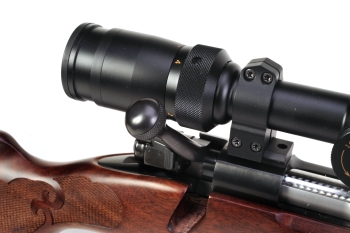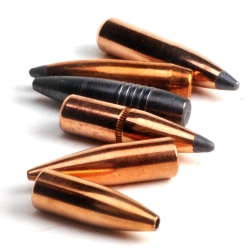 Some time has passed since Part I was written. To tell you the truth, I wanted to spend more time with this Winchester, both handling and shooting, to see if first impressions would last or if some new perspective would be born out of experience. The whole shutdown of the historical Winchester plant and discontinuation of the Model 70 and lever guns left such a bad taste in my mouth I had to invest time into this project to assure I was evaluating the firearm and not the company.
Some time has passed since Part I was written. To tell you the truth, I wanted to spend more time with this Winchester, both handling and shooting, to see if first impressions would last or if some new perspective would be born out of experience. The whole shutdown of the historical Winchester plant and discontinuation of the Model 70 and lever guns left such a bad taste in my mouth I had to invest time into this project to assure I was evaluating the firearm and not the company.
Even though chambered for the modern 270 Winchester Short Magnum cartridge, the look and feel of the rifle is that of the original Featherweight of the 1950’s; blued steel and satin finished walnut. The only points that betray the gun’s traditional heritage is the use of glossy plastic for grip cap material, which really cheapens the appearance of an otherwise attractive firearm, and the cheese grater sharp laser cut checkering that is tough on the hands in handling and when shooting. The checkering will smooth over time, but the grip cap is a wart that needs to be replaced.

A 2-10×42 scope was installed with steel Warne hardware. While the Winchester has a two lug bolt with 90° bolt open rotation, the dog legged bolt handle clears even a large scope eyepiece with medium height rings. Because these particular Warne mount base fastener holes are symmetrical, each can be flipped 180° to move it’s ring cross slot location a 1/2″ forward or aft. In the case of this relatively short tube Weaver Scope, both bases were oriented with their ring cross slots located aft. The term “Featherweight” is relative. In comparison to the Model 70 Deluxe, it is about a pound lighter, however, with a scope of nominal weight in place, the gun tips the digital scales at 9 lbs 3 oz.
The WSM that really is a magnum…
I don’t want to revisit the history of the Winchester Short Magnum… but then I also don’t want to count down from a trillion, watch paint dry or listen to Sarah McLachlan twitch her nose and warble her way through a sappy song. Explaining the history of the WSM would be tedious, boring and… zzzz. Sorry. Where was I? Oh yeah. My original take on the WSM lineup, when Winchester got done hatching them one at a time, was that the 325 WSM was an unnecessary and diminished power 8mm version of the 338 Winchester Magnum and the 300 WSM was an unnecessary diminished power version of the 300 Winchester Magnum. Right about the time the 7mm and 270 versions of the WSM came along, things began looking up. These two releases represented solid magnum ballistic performance.
 Then the logic took a vacation and the 25 WSSM and the 223 WSSM cartridges escaped and it was back to the underpowered and unnecessary rehash of established cartridges. In this case, 25 WSSM = 257 Weatherby, 25-06 Remington and the 223 WSSM = 220 Swift and 22-250 Remington. Sadly, the WSSM cartridge that made a lot of sense appears to have gotten been put to rest, the 243 WSSM, so I’ve refrained from building a rifle on this chamber and I do not believe any manufacturer is currently producing a bolt action in this caliber. “Joe, please stop. I don’t care about this… stuff. You’re making me want to poke my eyes out with a pointed stick so I don’t have to read anymore. Shouldn’t you be writing about something other than guns like, perhaps, golf?” Critics! However, I have been thinking about shifting over the excitement of lawn furniture… or anything Scandinavian.
Then the logic took a vacation and the 25 WSSM and the 223 WSSM cartridges escaped and it was back to the underpowered and unnecessary rehash of established cartridges. In this case, 25 WSSM = 257 Weatherby, 25-06 Remington and the 223 WSSM = 220 Swift and 22-250 Remington. Sadly, the WSSM cartridge that made a lot of sense appears to have gotten been put to rest, the 243 WSSM, so I’ve refrained from building a rifle on this chamber and I do not believe any manufacturer is currently producing a bolt action in this caliber. “Joe, please stop. I don’t care about this… stuff. You’re making me want to poke my eyes out with a pointed stick so I don’t have to read anymore. Shouldn’t you be writing about something other than guns like, perhaps, golf?” Critics! However, I have been thinking about shifting over the excitement of lawn furniture… or anything Scandinavian.
The 270 WSM, at 80 grains spill over full capacity, comes within 2 grains of the 270 Weatherby and surpasses the 270 Winchester by 13 grains. All operate in the same pressure neighborhood, 63,000 – 64,000 MAP. The Real Guns Barrel Burner Index for the 270 WSM is 18.5, compared to 18.6 for the 270 Weatherby and 15.7 for the standard 270 Winchester. Not enough for the WSM to establish single round discharge barrel glow, but enough to be labeled an overbore magnum. Fortunately, bullets made for both the 270 Weatherby and Winchester can generally handle the stress and strain of the WSM, so there is a pretty good size inventory of bullets of varying construction and weight available for handloaders. Brass is relatively inexpensive and also easy to come by.
Do they always have to be lined up and standing at attention?

Handloads began at 90 grains, a little lighter than we normally start with the 270 WSM, and ended at the high end of the 0.277″ bullet range, 150 grains. As would be expected, the 90 and 110 grain light weights are pretty spectacular on contact, with the exception of the GS Custom solid which holds together like the 140 and 150 grain heavy weights; tough, good penetration and demonstrated controlled expansion.
Bottom to top: Sierra 90gr, Hornady 110gr, GS Custom 110gr, Hornady 130gr, Sierra 140gr and Nosler 150gr. The GS Custom is a bullet of unique design with positive driving bands and a bore diameter shank. Moly coated and presenting little resistance to rifling, these bullets can be driven at charge levels that would create hazardous pressure levels with any bullet of conventional design.
| Bullet | Bullet Grains |
C.O.L. Inches |
Powder Type |
Charge Grains |
Muzzle Velocity fps |
Muzzle Energy ft/lbs |
100 Yd 3 Shot Group |
| Sierra #1800 | 90 | 2.700 | Varget | 62.0 | 3723 | 2771 | 1.3 |
| Sierra #1800 | 90 | 2.700 | BL-C2 | 64.0 | 3711 | 2753 | 1.1 |
| Hornady #2720 | 110 | 2.720 | Re17 | 63.5 | 3476 | 2952 | 0.4 |
| Hornady #2720 | 110 | 2.720 | IMR 4350 | 65.5 | 3442 | 2894 | 0.8 |
| GS Custom HV | 110 | 2.725 | Re 17 | **65.0 | 3560 | 3096 | 1.1 |
| GS Custom HV | 110 | 2.725 | H 414 | **67.0 | 3547 | 3074 | 0.9 |
| Hornady #2730 | 130 | 2.735 | Re19 | 66.0 | 3297 | 3139 | 0.7 |
| Hornady #2730 | 130 | 2.735 | IMR 7828 | 68.0 | 3284 | 3114 | 0.9 |
| Sierra #1845 | 140 | 2.785 | MagPro | 70.5 | 3239 | 3262 | 0.5 |
| Sierra #1845 | 140 | 2.785 | Re 22 | 67.0 | 3218 | 3220 | 0.8 |
| Nosler #16323 | 150 | 2.825 | MagPro | 70.0 | 3166 | 3339 | 0.7 |
| Nosler #16323 | 150 | 2.825 | Re 22 | 66.5 | 3158 | 3323 | 1.1 |
| **Loads for these unique bullets cannot be used for any other of the same weight All loads used CCI 200 Large Rifle Primers |
|||||||
The handloading exercise took a bit of time. The Winchester Featherweight responded differently to handloads than prior efforts with this cartridge and Winchester Model 70 standard and Remington rifles. While all are 24″ barrel guns, this one squeezed out a bit more velocity across the board and seemed to show fewer signs of pressure. Could be weather to some extent. The shooting temps were sub 20°F, but most of the powder selected is made for extreme temperatures and is actually pretty stabile across a wide range in temperature. Accurate gun. Maybe it’s this Winchester’s tight bedding and use of glass at key locations, or maybe the overall weight of the rifle made it more comfortable to shoot. Good trigger also and good scope position.
I guess I have to like it…

Emotionally, I don’t want to like the Winchester Model 70 Featherweight because of the Winchester plant closing and temporarily suspended production of American legacy firearms… and because of that really cheesy pistol grip cap. Intellectually (now there is a word that doesn’t typically come up in association with my work), I have to accept that firearm manufacturing is a business and that the steps taken by FN will assure Winchester products will remain in production. The guns seem to have also gained something in the way of improved quality as well. So this has become my purchased, personal 270 WSM and the best of the bunch I’ve handled in terms of both appearance and function… with the exception of that plastic grip cap. Did I mention the grip cap?
The Winchester Model 70 Featherweight Part I
The Winchester Model 70 Featherweight Part II

Email Notification